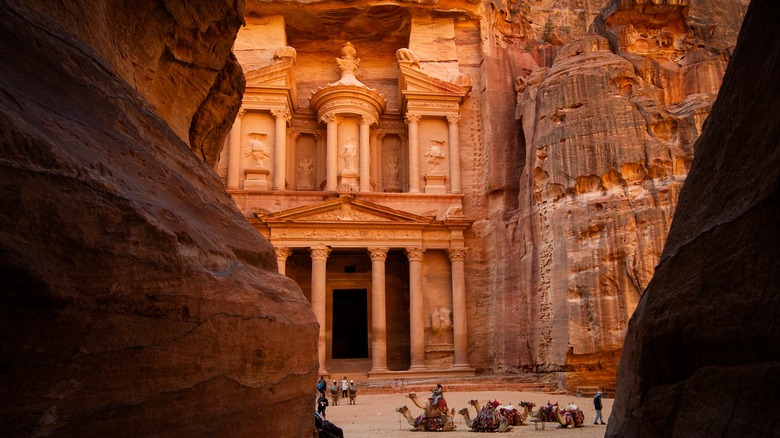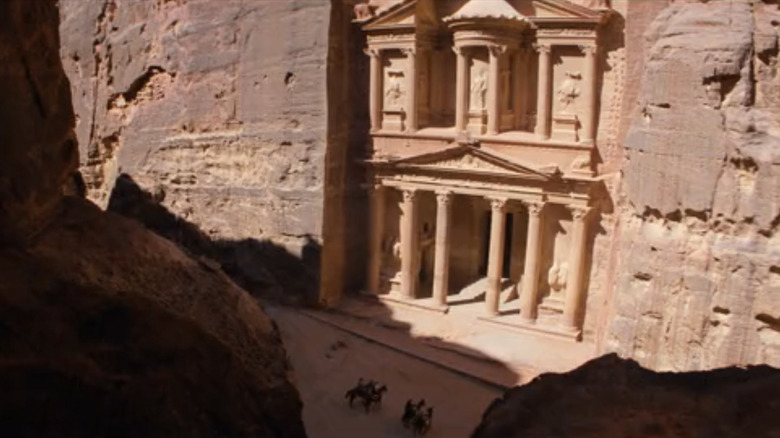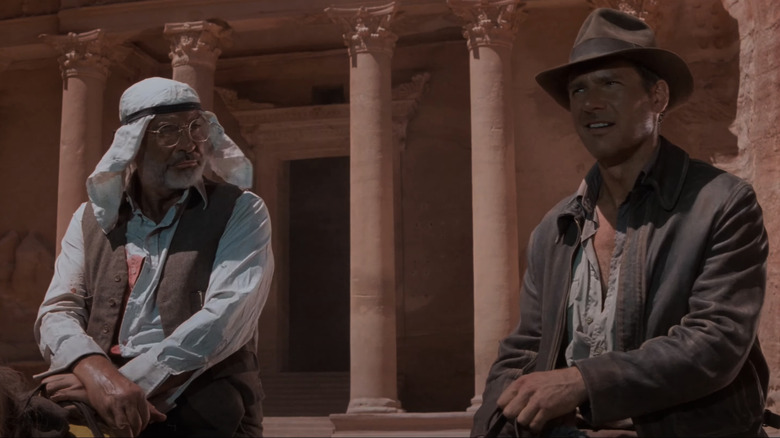The Real-Life Tomb Discovered Under An Indiana Jones Filming Location
When the world first met Indiana Jones in 1981's "Raiders of the Lost Ark," he was raiding the Temple of the Chachapoyan Warriors in the heart of the Peruvian jungle. His goal: retrieve the mysterious golden idol. In order to do so, however, the intrepid explorer had to overcome several death trap surprises, including a giant rolling boulder that chased Henry Jones Jr. all the way out of the temple and into the hands of the sinister René Belloq, who stole the golden idol — really just a cheap, repurposed souvenir — right out of Indiana Jones' hands.
It's a truly legendary sequence in cinema history that has become almost as iconic as the titular archeologist himself. Of course, the ingenious booby traps weren't exactly the most historically accurate element of the film, but that doesn't mean the "Indiana Jones" franchise hasn't intersected with real history throughout its run.
For example, the 1989 threequel, "Indiana Jones and the Last Crusade," shot several scenes at Jordan's Al-Khaznah, or "The Treasury," with the facade of this ancient, rock-cut tomb doubling as the entrance to the site where the Holy Grail rests. In 2024, however, archeologists discovered a secret tomb beneath the historical site that sounds as if it came straight out of an "Indiana Jones" movie itself.
Al-Khazneh is a marvel of historical architecture
Built in Petra in the first century A.D., Al-Khazneh is thought to have been constructed as a mausoleum and crypt — though experts have long debated its purpose, which remains one of the many secrets of Petra. Though its name literally translates as The Treasury, the site was seemingly intended as a final resting place for the Nabataean king Aretas III. If that was the case, how did the impressive structure get its title? Well, an Egyptian pharaoh was once said to have stashed his treasure in the decorative stone urn — a story which caught on with locals and gave the tomb its incongruous name.
The Treasury is an example of an ancient structure carved from solid rock – in this case pink sandstone cliffs — and houses a main chamber alongside three antechambers. The Nabataeans constructed much of Petra in this same way, carving an entire city into the sandstone cliffs — a feat ultimately recognized as one of the New Seven Wonders of the World in 2007.
Today, Al-Khazneh is one of the most recognizable and visited parts of Petra, and it was beneath this historical marvel, two millennia after it was first constructed, that archeologists discovered a secret tomb that housed at least 12 human skeletons and an array of ancient artifacts — one of which resembled the Holy Grail itself.
The hidden tomb beneath Al-Khazneh
The discovery of Al-Khazneh's hidden underground tomb follows the excavation of two other tombs found beneath the left side of the edifice back in 2003. In 2024, executive director of the American Center of Research Dr. Pearce Paul Creasman led a team of archeologists who used ground-penetrating radar to reveal that the right side of Al-Khazneh matched the physical characteristics of the left side. This suggested that more hidden rooms existed beneath the structure. Based on this discovery, in August 2024, Creasman and his team were given permission to excavate the hidden tomb, along with a film crew. Their work revealed yet more surprises hiding within.
Inside the newly uncovered tomb, Creasman and company discovered a host of artifacts that are thought to be more than 2,000 years old. Among them were bronze, iron, and ceramic goods and vessels. But by far the most compelling discovery was the complete skeletal remains of at least 12 humans, one of which was holding a ceramic chalice which was surprisingly reminiscent of the fictional Holy Grail.
Of course, in "The Last Crusade," Al-Khaznah is used to represent the site where the Holy Grail rests, so this discovery was particularly significant for the research team. Josh Gates, host of Discovery Channel's "Expedition Unknown," on which the excavation was featured, told CNN, "It really was this awesome moment of history imitating art."
The discovery is a breakthrough for historical research
While finding a Holy Grail-shaped chalice in a tomb beneath the site where Indiana Jones himself found the mystical artifact is a neat coincidence, the discovery of yet another hidden tomb beneath Al-Khaznah was significant for likely being the largest collection of human remains found in one place in Petra. As Josh Gates put it to CNN, "This is a hugely rare discovery — in the two centuries that Petra has been investigated by archaeologists, nothing like this has been found before. Even in front of one of the most famous buildings in the world."
What's more, the tomb and its remarkable contents give researchers one of their best looks yet at the lives of the Nabataeans, whose ancient society remains largely mysterious. The Nabataean society existed between the fourth century B.C. to 106 A.D., and Petra, then known as Raqmu, is thought to have been the capital.
Researchers are unclear on who among Nabataean society would have been buried in this subterranean tomb, but the discovery of this particular room, which had remained completely undisturbed for two millennia, provides one of the best insights into this mysterious society yet.



